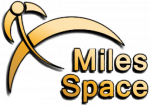Miles Space is honored and grateful to be referenced multiple times in the white paper to come out of this year’s ASU Deep Space Summit. This follows our 2nd consecutive year of showing up in the NASA State of the Art report (2021 and 2020) for our novel approaches to propulsion and communications through our deep technical partnership with Atlas Space Operations.
 Our overall mission of accelerating commercial deep space exploration, originally defined by our NASA CubeQuest Challenge win, awarded our satellite a slot on the Artemis-1. Although we are flying the older generation of the ConstantQ thrusters on Artemis-1, our latest commercial offering has evolved several generations. You can find out more about the new M1.4 on the Miles Space site.
Our overall mission of accelerating commercial deep space exploration, originally defined by our NASA CubeQuest Challenge win, awarded our satellite a slot on the Artemis-1. Although we are flying the older generation of the ConstantQ thrusters on Artemis-1, our latest commercial offering has evolved several generations. You can find out more about the new M1.4 on the Miles Space site.
As highlighted in the paper, thrusters aren’t our only product line at Miles Space. We are currently engaged in  several research and development projects involving signal processing for communications, a mission critical element for commercial deep space exploration. The white paper touches on how we took the novel approach of using the powerful Open Source software GNU Radio and combined it with the ingenuity of an SDR (Software Defined Radio), thus providing “inexpensive systems developed for low-budget missions” using our unique software-based solutions instead of expensive and burdensome hardware to do the heavy lifting.
several research and development projects involving signal processing for communications, a mission critical element for commercial deep space exploration. The white paper touches on how we took the novel approach of using the powerful Open Source software GNU Radio and combined it with the ingenuity of an SDR (Software Defined Radio), thus providing “inexpensive systems developed for low-budget missions” using our unique software-based solutions instead of expensive and burdensome hardware to do the heavy lifting.
Being recognized for our contributions, both past and future, to the development of space exploration technology is deeply appreciated by the entire engineering and marketing team at Miles Space. Our partners, including Rocketstar and Atlas Space Operations, have provided an environment where we can make our unique technologies known to the industry leaders who can utilize them the best.
If you want to learn more, you can find out about the ASU Interplanetary Initiative Summit at their website, and you can review and download the “Interplanetary CubeSats: Summary of the Current Thinking, Approaches and Lessons Learned” from our site.

